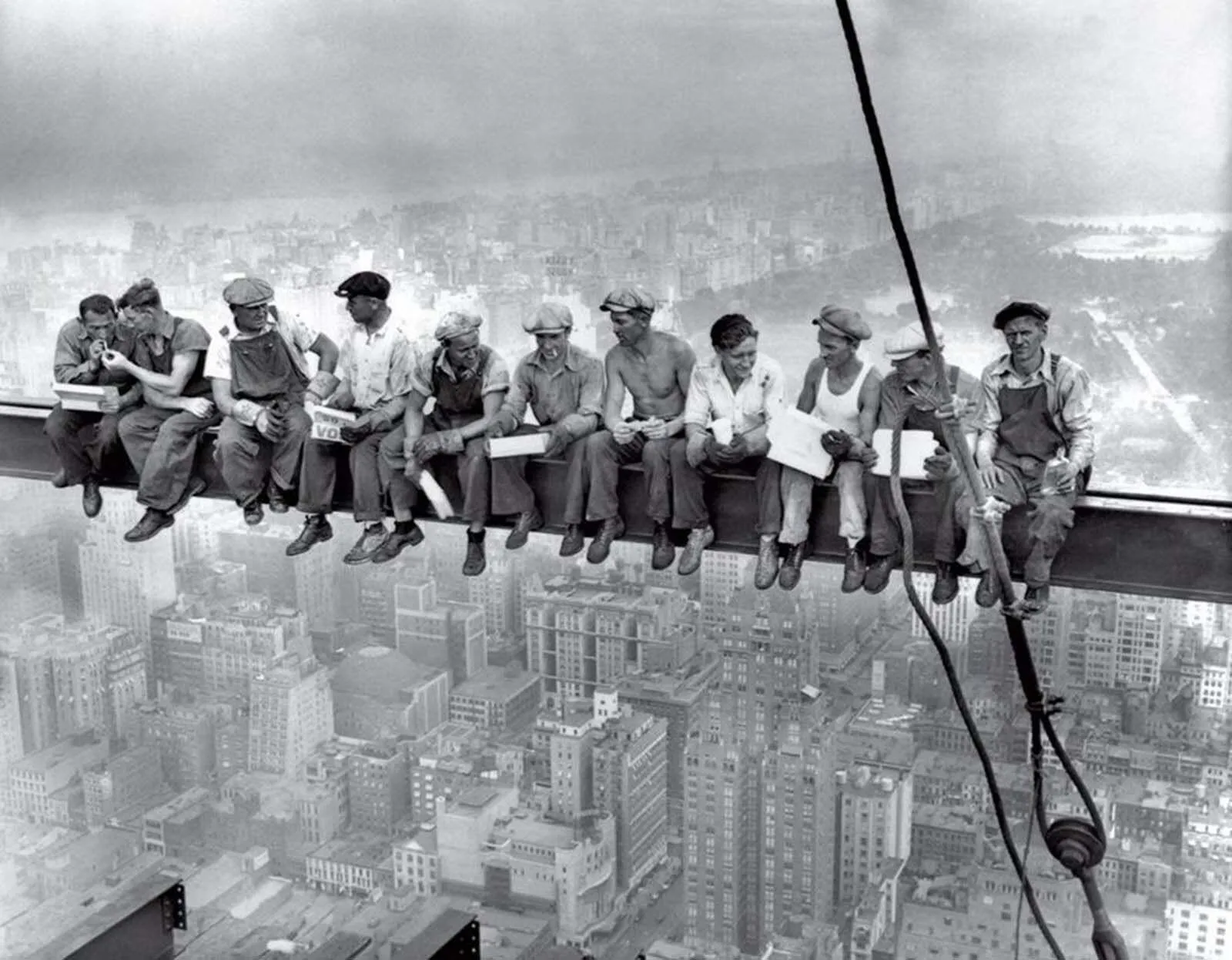The Grand Vision Behind Rockefeller Center
Conceived during the depths of the Great Depression, Rockefeller Center was more than a real estate venture—it was a statement of faith in progress. Commissioned by John D. Rockefeller Jr., the complex was designed to revitalize midtown Manhattan and provide employment during a time of widespread economic hardship. Construction began in 1931 and continued through the decade, culminating in a 14-building complex that combined commercial office space, broadcasting studios, retail, and public art. The 1939 booklet emphasized not just the scale of the project, but its integration of art, technology, and urban planning. It described the Center as “a city within a city,” where every corridor, plaza, and spire was conceived with purpose and aesthetic harmony.
The architectural team, led by Raymond Hood and a consortium of firms under the name Associated Architects of Rockefeller Center, embraced the Art Deco style with bold geometric forms, vertical emphasis, and lavish ornamentation. The centerpiece, the RCA Building (now known as 30 Rockefeller Plaza), soared 70 stories into the sky and served as the symbolic and functional core of the complex. The 1939 booklet highlighted this structure as a marvel of engineering and design, noting its steel frame, limestone cladding, and innovative use of setbacks to comply with zoning laws while maximizing light and air.
Rooftop Gardens: Oases Above the City
One of the most enchanting features celebrated in the 1939 booklet was the series of rooftop gardens located atop several buildings in the complex. These green spaces were not merely decorative; they represented a revolutionary approach to urban living, offering respite from the noise and congestion of the streets below. The gardens were designed by landscape architect Ralph Hancock, who transformed the upper levels of the British Empire Building and La Maison Francaise into lush, terraced retreats filled with flowers, shrubs, and winding paths.
Visitors in 1939 could access these gardens through special guided tours or by invitation. The booklet described them as “floating gardens in the sky,” where one could enjoy panoramic views of the city while surrounded by blooming azaleas, ivy-covered trellises, and the gentle sound of fountains. These spaces were especially popular during spring and summer, drawing office workers, tourists, and dignitaries alike. Though the original rooftop gardens were dismantled in the 1980s due to maintenance challenges, their legacy lives on in modern green roof initiatives across New York.
The RCA Building Murals: Art in the Age of Industry
No discussion of the 1939 Rockefeller Center experience is complete without mentioning the controversial and captivating murals inside the RCA Building. The most famous of these was Diego Rivera’s Man at the Crossroads, commissioned for the lobby in 1933. Though the mural was ultimately destroyed due to its inclusion of communist imagery (notably a portrait of Vladimir Lenin), the 1939 booklet still acknowledged the building’s commitment to bold artistic expression. By 1939, the space had been replaced with murals by other artists, including Ezra Winter’s Wisdom, Sound, Light, which celebrated human achievement in science and the arts.
The booklet highlighted how art was woven into every aspect of the Center’s design—from bronze sculptures in the lower plaza to intricate ceiling mosaics in the underground concourse. These works were not afterthoughts but integral components of the overall vision, reinforcing the idea that beauty and functionality could coexist. The RCA Building’s grand lobby, with its soaring ceilings and radiant color schemes, was described as “a cathedral of modern enterprise,” where workers and visitors alike could feel inspired by their surroundings.
Early Television Demonstrations: The Future is Live
Perhaps the most futuristic attraction promoted in the 1939 booklet was the live television demonstrations hosted by RCA (Radio Corporation of America) in the RCA Building. As the official broadcaster of the 1939 New York World’s Fair, RCA used Rockefeller Center as a hub for experimental TV broadcasts. Visitors could witness the marvel of electronic television—still a novelty for most Americans—by watching live feeds of events, studio performances, and even weather reports.
These demonstrations were held in the RCA Exhibition Hall and featured the latest Iconoscope cameras and TRK-12 receivers. The booklet described television as “the eye of the future,” capable of bringing the world into homes with unprecedented clarity and immediacy. Notably, the first televised baseball game, a college match between Columbia and Princeton, was broadcast from Baker Field to screens at Rockefeller Center in May 1939. This moment marked the beginning of a new era in mass communication.
The 1939 World’s Fair itself was televised in segments, with President Franklin D. Roosevelt’s opening speech becoming the first presidential address ever broadcast on television. Rockefeller Center served as the nerve center for these historic transmissions, positioning itself at the forefront of the media revolution.
Then and Now: A Journey Through Time
1939: Rooftop Gardens in Full Bloom
In 1939, the rooftop gardens were a symbol of luxury and innovation, offering a rare green escape above the urban grid. Today, while the original gardens are gone, the concept has been revived in spirit through the Top of the Rock observation deck, which provides 360-degree views of the city and includes landscaped areas and seasonal floral displays.
1939: Murals as Political Statements
The murals of 1939 sparked debate and censorship, reflecting the tensions of the pre-war era. In 2023, the RCA Building (now Comcast Building) continues to host public art, though with a more corporate sensibility. Nevertheless, the legacy of Rivera and Winter endures in New York’s vibrant mural scene and public art programs.
1939: Television as a Wonder
What was once a curiosity in 1939 has become the backbone of modern media. Today, 30 Rockefeller Plaza remains a broadcasting hub, home to NBC Studios and live shows like Saturday Night Live and Today. The spirit of innovation lives on, now in high-definition, streaming, and digital formats.
Download the Cover Art: A Slice of 1939
The original 1939 Rockefeller Center Tourist Booklet featured a striking cover design—typically a blend of bold typography, Art Deco motifs, and skyline illustrations that captured the optimism of the era. While the full booklet is a rare collector’s item, we’re pleased to offer a high-resolution recreation of the cover art for personal use.
📥 Download a 4K desktop wallpaper of the 1939 booklet cover and bring a piece of New York history to your screen.
Interactive Experience: Page-by-Page Digital Flipbook
Thanks to digitization efforts by the New York Public Library and private collectors, the full 1939 Rockefeller Center Booklet is now available as an interactive page-turner. This embedded PDF allows you to browse the original text, maps, photographs, and advertisements just as a visitor would have in 1939. Highlights include floor plans of the underground concourse, promotional material for retail tenants like Bonwit Teller and Joseph Horne Company, and illustrated guides to the Center’s architectural details.
The flipbook experience is not only nostalgic but educational, revealing how mid-20th century Americans imagined the future of cities, technology, and leisure. It’s a valuable resource for historians, architects, and anyone fascinated by the evolution of urban life.
Why the 1939 Booklet Still Matters
The 1939 Rockefeller Center Tourist Booklet was more than a promotional pamphlet—it was a cultural artifact that captured a pivotal moment in American history. It reflected the confidence of a nation emerging from economic despair, embracing technological progress, and reimagining the urban environment. The booklet’s emphasis on beauty, innovation, and public access helped shape how people experienced cities for decades to come.
Moreover, it served as a bridge between two great expositions: the ongoing development of Rockefeller Center and the 1939 World’s Fair, whose theme was “The World of Tomorrow.” By positioning itself as a companion to the Fair, the booklet reinforced the idea that Rockefeller Center was not just a destination, but a vision of what the future could look like—integrated, artistic, and technologically advanced.








